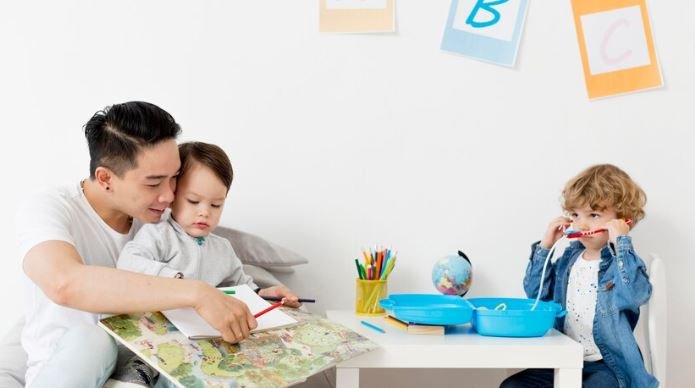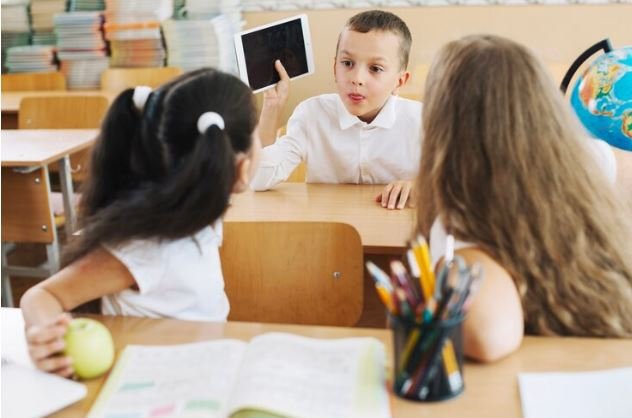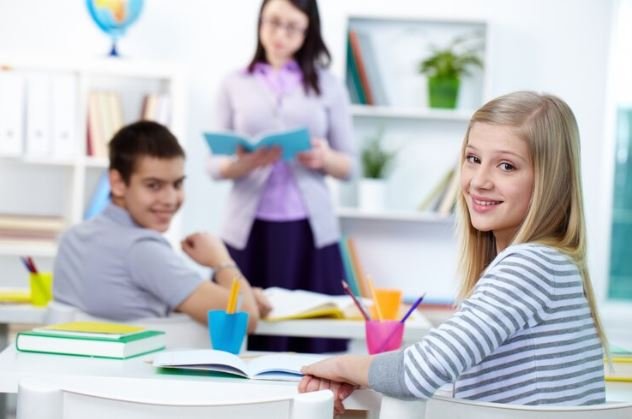It is the first phase in the long journey of formal learning that most kids begin. It is the first step of a journey filled with learning so much more about the kinds of knowledge and skills, as well as understanding developed in this world.
Elementary education refers to those years of our children’s academic journey at school from kindergarten until about fifth or sixth grade. At this age, children are introduced to reading, writing, math skills and more.
What is Elementary Education?
Primary education refers to the years of schooling as those are completed from approximately ages 5–11. It is the base for all further learning throughout life. The bulk of the material in elementary school includes the likes of math, science, reading and social studies.
They also learn to read, write, understand numbers and do math and they learn how to work with others, solve problems, and think creatively.
This early education simply teaches children the fundamentals of these subjects and provides them with the tools that they are going to need to continue learning about them later on down the line.
The purpose is to ensure every student is comfortable with what they already know and capable of moving on to the more complex stuff in middle school and high school.
Elementary schooling is critical.
Elementary education is vital because it provides the basic tools for future learning. It is almost impossible to learn subjects like science or history if you do not have a basic reading skill. If students hadn’t fully learned how to add and subtract, they wouldn’t be able to solve more complicated problems in their later years.
Moreover, elementary education imparts the basic skills of life as well. It includes things like learning how to listen carefully, work with others, and stick to a task.
And this is as necessary to learn as remembering facts these are the skills young people need so that they become good solvers and thinkers when they grow up.
This education phase is also very beneficial for morale building. And as they begin to learn new things, and see that what was once incomprehensible is now understandable, something magical begins to transpire self-belief. That confidence will carry through their entire lives, not just in school.

What kids learn in primary School
During elementary school, students are exposed to all the diverse types of subjects all with their series of lessons and trials. Consider this detailed coverage of some of the major important subjects:
Reading and Writing: This is one of the biggest things your child will learn to do while they are in elementary school. It starts with letters and sounds, then moves to word reading, followed by sentence reading, and finally (the goal) of whole text reading.
As they progressed, they wrote their sentences, then entire paragraphs, followed by forming short stories. Without reading and writing, history and science are nothing to us.
Math: Math is a large part of elementary education as well. In the lower grades, students are taught about numbers, counting, addition and subtraction.
But as they grow older, they start discovering more than just addition, like multiplication, division, shapes and measurements. In particular, math provides a framework for solving problems and reasoning about the world, which are fundamental tools one needs in any domain.
Science For Elementary science where students learn about the world. They could learn about animals, plants, the weather or even outer space. They learn how to question and discover answers through experiments and observations. The nature of science gets students to want to know more about the world and how things work.
How about Social Studies (Elementary Social studies introduces history and geography, plus the communities all around you) They study key events in history, other societies and how people come together to form neighbourhoods. This is a subject which enables students to make sense of the world and their role in it.
Art and Music: Creative expression plays a huge role in the lives of young children. Students could take art classes where they learned to, draw, paint, or even sculpt. Music they learn about rhythm, songs, and instruments in music class. They are subjects which help students explore their creativity and find a sense of confidence in their special gifts.
The Post-Human World: Making Sure Elementary Education Expands Human Capability
It’s true, after all, that elementary education is learning facts and skills as well as becoming a better person. In the early years, children are taught responsibility, working with others and problem-solving.
Students learn through skills-specific activities such as students learn how to share ideas, listen to others and solve problems together if working in a group.
Pushing for teamwork is more than necessary in our beloved school and even outside of the walls, we will need this cooperation if we want life to be a walk of roses. It helps students understand the meaning of cooperation and respecting another person.
You may often find elementary education helping in making little citizens who can think for themselves. When they work out a math problem or conduct an experiment in science, their brain is engaged in finding the solutions. This critical way of thinking will help students to be better problem solvers, something they will take with them for the rest of their lives.
Developing self-discipline is another critical part of elementary education. Taking ownership of their learning, students master the ability to stay on task and complete assignments and, in turn, get better at time management. Each of these are vital abilities for not only obtaining a good education but will also serve them through their professional careers.
The Importance of Teachers in Child Primary Education
Teachers are one of the most significant factors in elementary education. They are not there to just extend lessons: they too, must accompany the student on their quest to learn.
The teacher can keep her students understanding tough concepts, and give those the ability to ask queries, making the lesson interesting and interactive.
Elementary teachers have a wide range of tools to teach students. Lessons could be as simple as reading through books, doing an activity together, playing some games and having discussions. This variety keeps students engaged and ensures that a wide range of learning styles are catered for.
Teachers also supply significant emotional anchors. They help students to feel more secure in the class, and boost their self-confidence and motivation. A teacher who believes in their students can greatly impact how those students view school and ultimately learning.

Playful and Explorative Learning
Elementary learning is not a one-dimensional experience of seated-at-desk activities and developing textbook knowledge. Playing and exploring are also critical ways in which young children learn.
Recess or playtime gives students time to move their bodies, interact with other children, and learn through play. Keeping the classroom lively and interesting with all these games and activities makes learning a fun experience.
Some examples include playing a math game to practice addition and subtraction. Or, they may go outside and learn about plants and animals during a science lesson. Through these hands-on experiences, students can remember what they have learned and are allowed a chance to practice their knowledge in a more applicable field.
One of which, is learning through play for creativity. All this, when left to students play, they use their imagination to generate problems and solve them as well as make up stories and new ideas. It fosters creativity and innovation in students and makes them willing to learn more and think better.
Problems in Primary Education
Elementary education is the best time for learning and growth, but it is also very challenging. This could be particularly difficult for students who are not adept at something, e.g. math or reading, and might need additional reinforcement from their teachers or their parents.
So please, we have to remind ourselves that every student learns at their own pace and with the right support they can conquer these hurdles.
Another problem is that remaining as profitable is easier said than done. The younger kids would be so very active and would have great difficulty being still for long periods.
It was new information to me that teachers had developed strategies like breaks and interactive learning solutions throughout the day to help students remain focused and engaged with their work.
Students might also feel anxious or self-conscious about finding friends or joining new things. On top of the title, I remind myself that SK/D was a big transition and it’s okay that it might overwhelm you slightly too. What helps is the support that students get from their teachers, parents and friends.
Ways Parents Can Help With Elementary School Education
How do parents help their child out in elementary school, assist him with assignments and raise a HONEST person? Parents become the soul of support during this period.
Engaging in the Learning of Your Child As responsible parents, involving in your child’s learning reinforces what is being taught at his school and boosts the desire to learn. Parents can help by:
- Read Together: Reading with your child is one of the best ways to support learning. Reading together promotes literacy and a lifelong love of being read to.
- Question Time: Ask your child about what they did at school today. It makes them remember what they have learned and also gives them a sense of accomplishment.
- Sponsored Content Encourages Curiosity Children are naturally curious. Whether it is the weather, animals or how things operate learning flies when curiosity is oiled.
Here are ways to encourage your child through Homework support: By assisting kids with homework, you introduce yourself as a caring parent. It is also a great way to keep up with what they are learning in school.
What Elementary Education Will Look Like In The Future
Elementary education is changing as the world changes. Technology similarly is taking on an expanded role in education, and new technology (computers, tablets) also were identified as areas No Child Left Behind has not adequately addressed. They can have their lessons, education games being interactive activities or something that will make learning more fun.
There is no escaping the fact that elementary education is evolving and will evolve to accommodate the needs of students in the future. However, the centre’s target will always remain constant help young minds lay a robust foundation for their tomorrow by imparting relevant skills, knowledge & values.
Conclusion
The time when a child learns the basics of education is as critical as it is thrilling elementary school. It teaches them to read, do math, and learn about science, but also how to engage their minds with curiosity and creativity, and most of all how to exist in a world where they will work together with others. Parents help keep education going at home and teachers guide their students and make learning exciting.
Play allows students to explore, wonder and be excited about the world and have students discover things they are good at. This is a view of elementary education in practice and will help children become well-rounded, motivated learners positioned for future learning.


